Have you ever wondered why some resumes seem to grab attention effortlessly, while others get lost in the pile? Well, the secret lies in how they are written. Crafting a resume is not just about listing your experiences; it’s an art of presenting your story in a way that captivates your potential employer. In this guide on how to write a resume, we will walk you through the steps to create a document that stands out in the competitive job market.
Picture this: Your resume is like a personal advertisement, a snapshot of your professional journey. Each section, word, and format you choose is a piece of that puzzle, coming together to showcase your skills, achievements, and potential. Whether you’re a fresh graduate stepping into the world of employment or a seasoned professional looking to make a career switch, a well-crafted resume can be your ticket to new opportunities.
In the following sections, we’ll dive into everything from understanding the basics of a resume to fine-tuning the details that make you shine. You’ll find handy tips, dos and don’ts, and maybe even a few ‘aha’ moments that will transform your resume writing process. So, let’s get started and make your resume not just good, but great!
How to Write a Resume: Understanding the Basics of a Resume
What exactly is a resume, and why is it so crucial in your job search? Think of a resume as a bridge between you and your dream job. It’s more than just a document; it’s a tool that communicates your story to potential employers. A great resume can open doors to new opportunities and set the stage for a successful job interview.
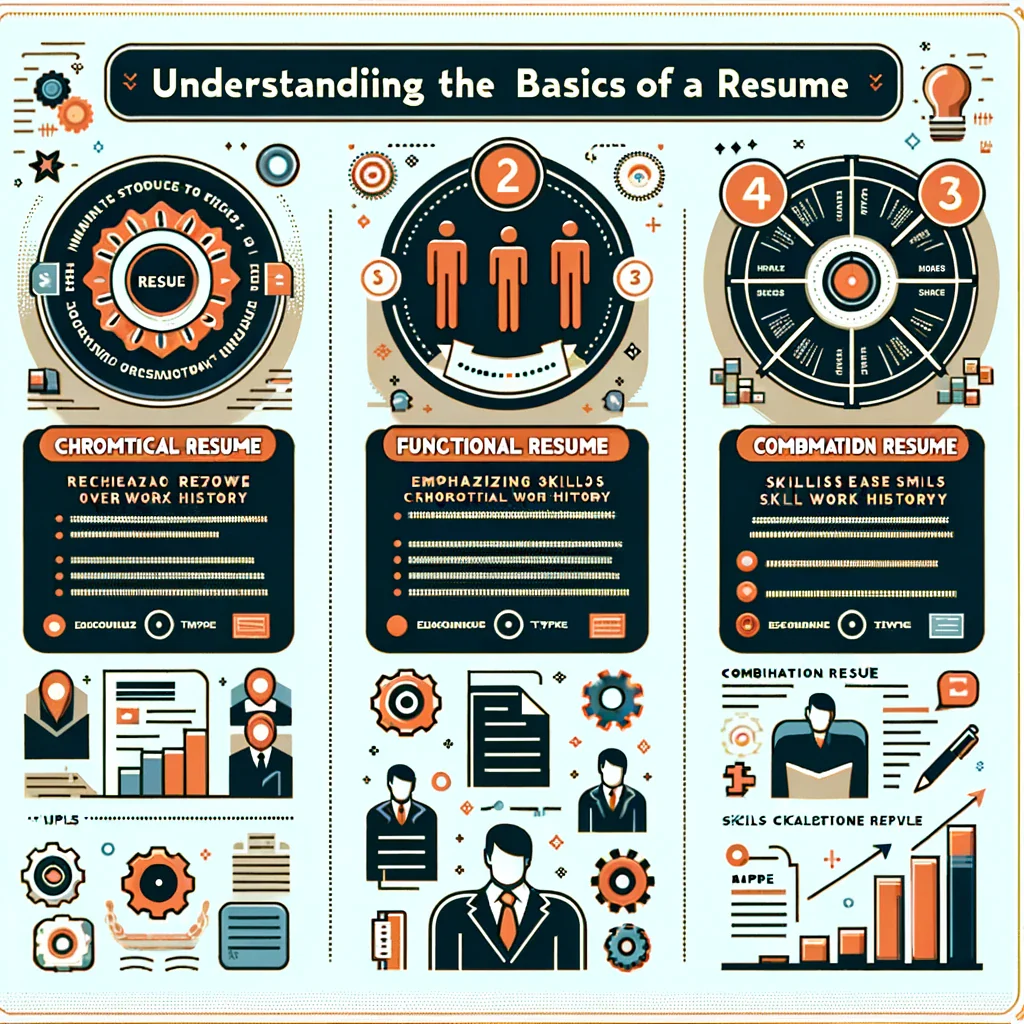
Different Types of Resumes:
- Chronological Resume: This is the most traditional format. It lists your work history in reverse chronological order. It’s perfect if you have a robust work history in your field.
- Functional Resume: Ideal for those with gaps in their employment or who are changing careers. This format focuses more on skills and less on the timeline of your work history.
- Combination Resume: As the name suggests, this format is a blend of chronological and functional styles. It highlights your skills, but also provides a chronological list of your work experiences.
Why is the Right Resume Format Important? Choosing the right format is like picking the right outfit for an interview; it has to suit the occasion. A well-chosen resume format highlights your strengths and downplays weaknesses, ensuring that a hiring manager sees the best version of your professional self.
Remember, no matter the format, your resume should be clear, concise, and focused. It’s your first impression, and you want to make it count!
How to Write a Resume: Before You Start Writing
Before you dive into writing your resume, there’s some groundwork to be done. This preparation can significantly enhance the quality of your resume.
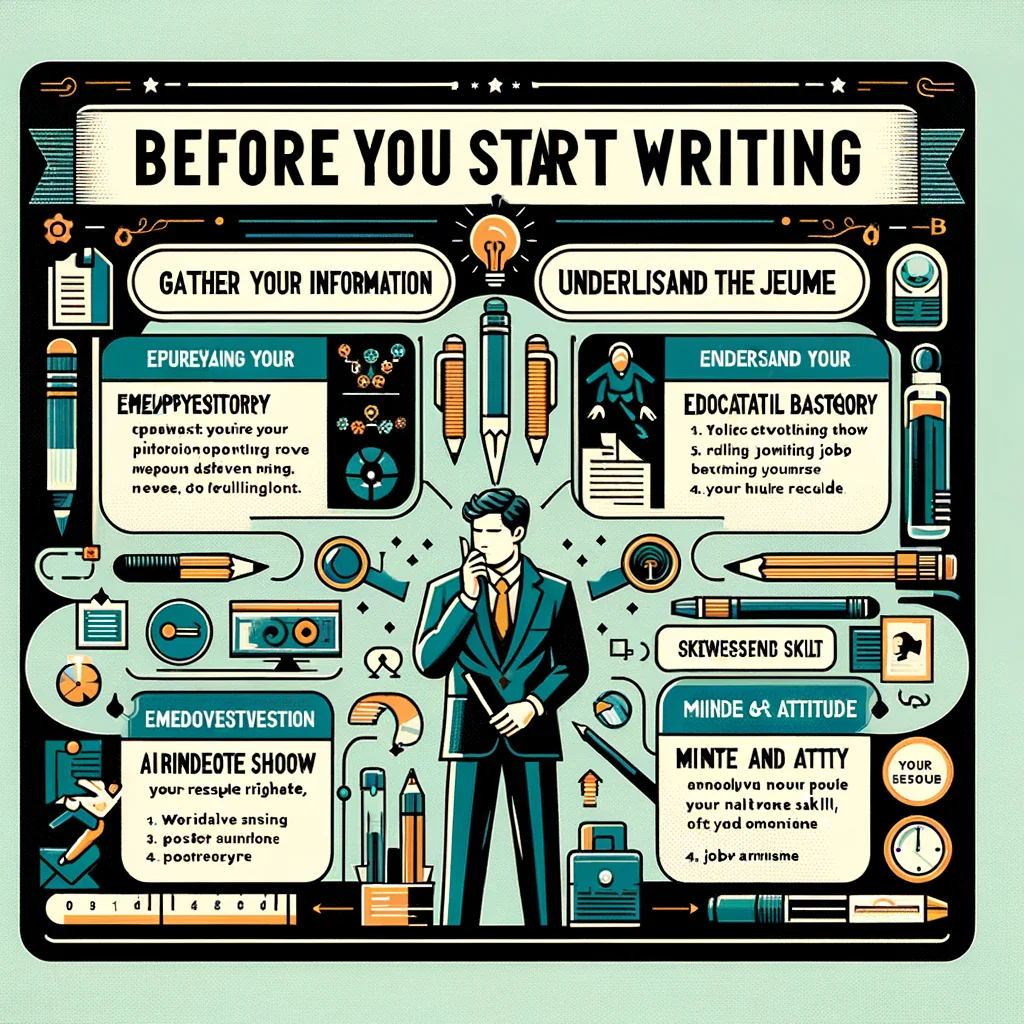
1. Gather Your Information
- Compile your employment history: List your past jobs, including the company name, your role, and the dates you worked there.
- Educational background: Have your degrees, institutions, and graduation dates ready.
- Notable achievements and skills: Think about any awards, certifications, or specific skills relevant to the job you’re applying for.
2. Understand the Job Description
- Read the job description carefully. It’s a goldmine of keywords and skills that the employer is looking for.
- Try to understand what the employer really needs. Which of your skills and experiences are most relevant?
3. Tailoring Your Resume
- Customization is key: Use the information from the job description to tailor your resume. Highlight the experiences and skills that align with the job requirements.
- Focus on relevance: If you’re applying for a marketing position, emphasize your marketing experience more than your brief stint in another unrelated field.
4. Mindset and Attitude
- Approach resume writing with a positive mindset. Remember, this document represents you. It’s your chance to make a great first impression.
- Be honest. Exaggerations or falsehoods can come back to haunt you.
Remember, a well-prepared resume is half the battle won. Taking the time to gather information and tailor your resume to the job can significantly increase your chances of landing an interview.
How to Write a Resume: Writing a Compelling Resume Header
The header of your resume is your first chance to make a good impression. It’s like the headline of a newspaper article – it should grab attention and make the reader want to know more.
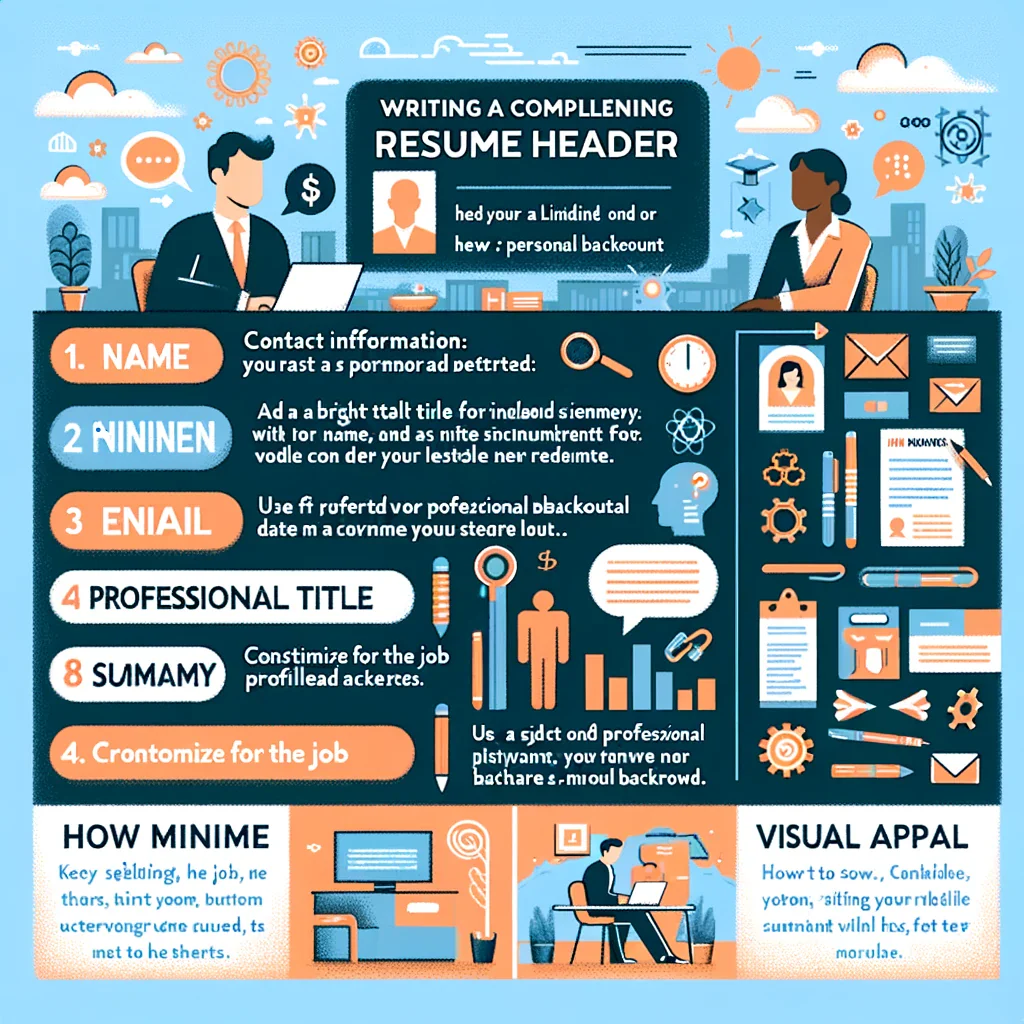
1. Contact Information
- Be sure to include: Your name, phone number, email address, and a LinkedIn profile or personal website if you have one.
- Make it prominent: Your name should be the most prominent part of the header, possibly in a larger font size.
2. Professional Title or Summary
- Add a Professional Title: Right under your name, add a brief title that reflects your current professional status or the position you’re seeking.
- Consider a Summary: A brief, two to three sentence summary of your professional background can provide context to your application. It should highlight your most important achievements and skills.
3. Making it Visually Appealing
- Keep it clean and professional: Use a simple, readable font. Avoid over-styling with too many colors or graphics.
- Alignment and spacing: Ensure that your header is well-aligned and uses space effectively, keeping it uncluttered.
4. Tips for a Standout Header
- Customize your header for the job you are applying for. If you’re in a creative field, a bit of color or a unique font can be effective.
- Always proofread your contact information. A small typo can mean a missed opportunity.
Remember, the header is your handshake with the hiring manager. Make it count by being clear, professional, and reflective of your career identity.
How to Write a Resume: Crafting Your Professional Experience Section
The Professional Experience section is arguably the most critical part of your resume. It’s where you showcase your work history and highlight your accomplishments. Here’s how to make it shine:
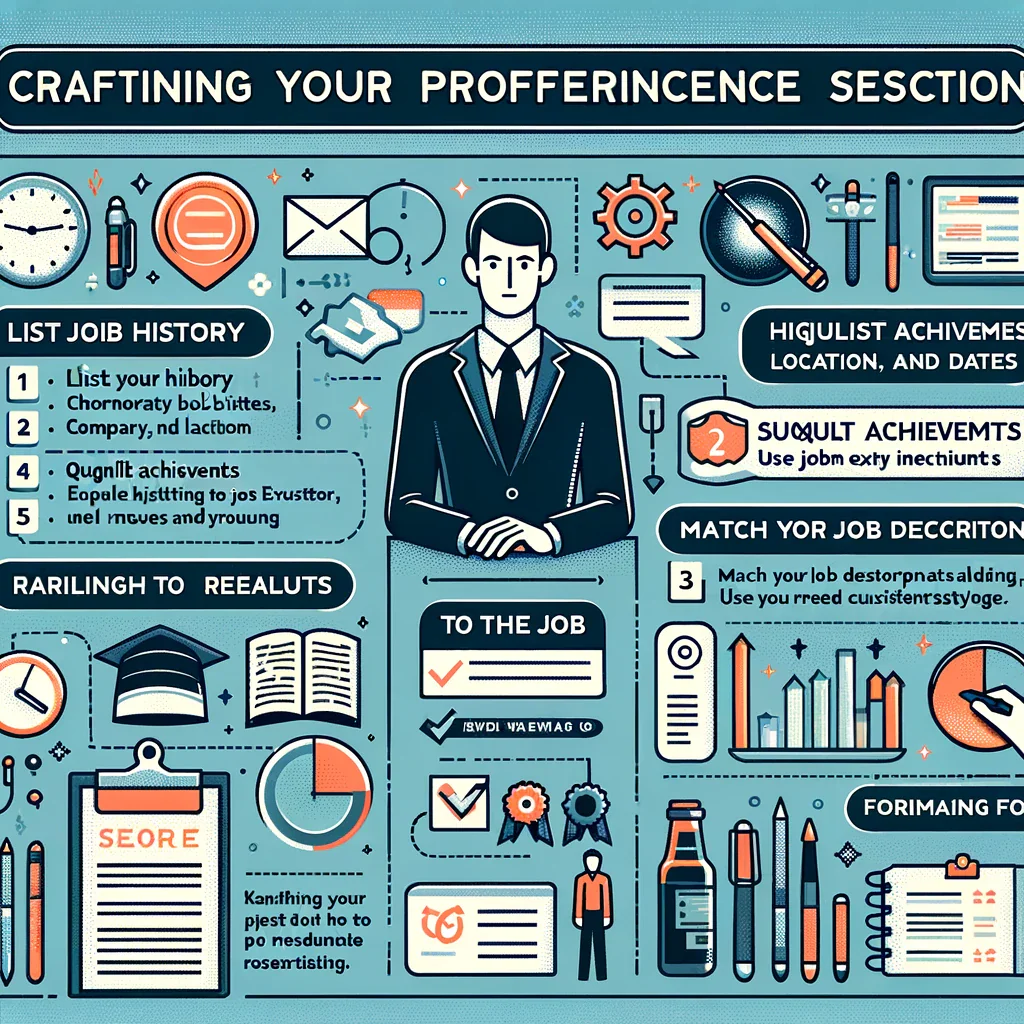
1. List Your Job History
- Chronological Order: Start with your most recent job and work backwards.
- Job Title and Company: For each position, include your job title, the company’s name, location, and the dates you worked there.
2. Highlighting Achievements and Results
- Quantify Your Achievements: Use numbers and statistics to demonstrate your impact. For example, “Increased sales by 20%” is more impactful than “Responsible for sales.”
- Use Action Verbs: Start bullet points with strong action verbs like ‘managed’, ‘led’, ‘developed’.
3. Tailoring to the Job
- Match the Job Description: Emphasize the parts of your job history that are most relevant to the position you’re applying for.
- Keywords: Incorporate keywords from the job listing to pass through Applicant Tracking Systems (ATS).
4. Formatting for Readability
- Bullet Points: Use bullet points to organize your accomplishments. This makes your experience easy to read and scan.
- Consistent Style: Maintain a consistent format for each job listing. This includes font size, bullet style, and spacing.
Remember, the goal of the Professional Experience section is to provide a clear and compelling narrative of your career journey. Be honest, be specific, and most importantly, be proud of your achievements!
How to Write a Resume: Education and Qualifications
Your education and qualifications are key components of your resume, especially if they are directly relevant to the job you’re applying for. Here’s how to effectively showcase your educational background:
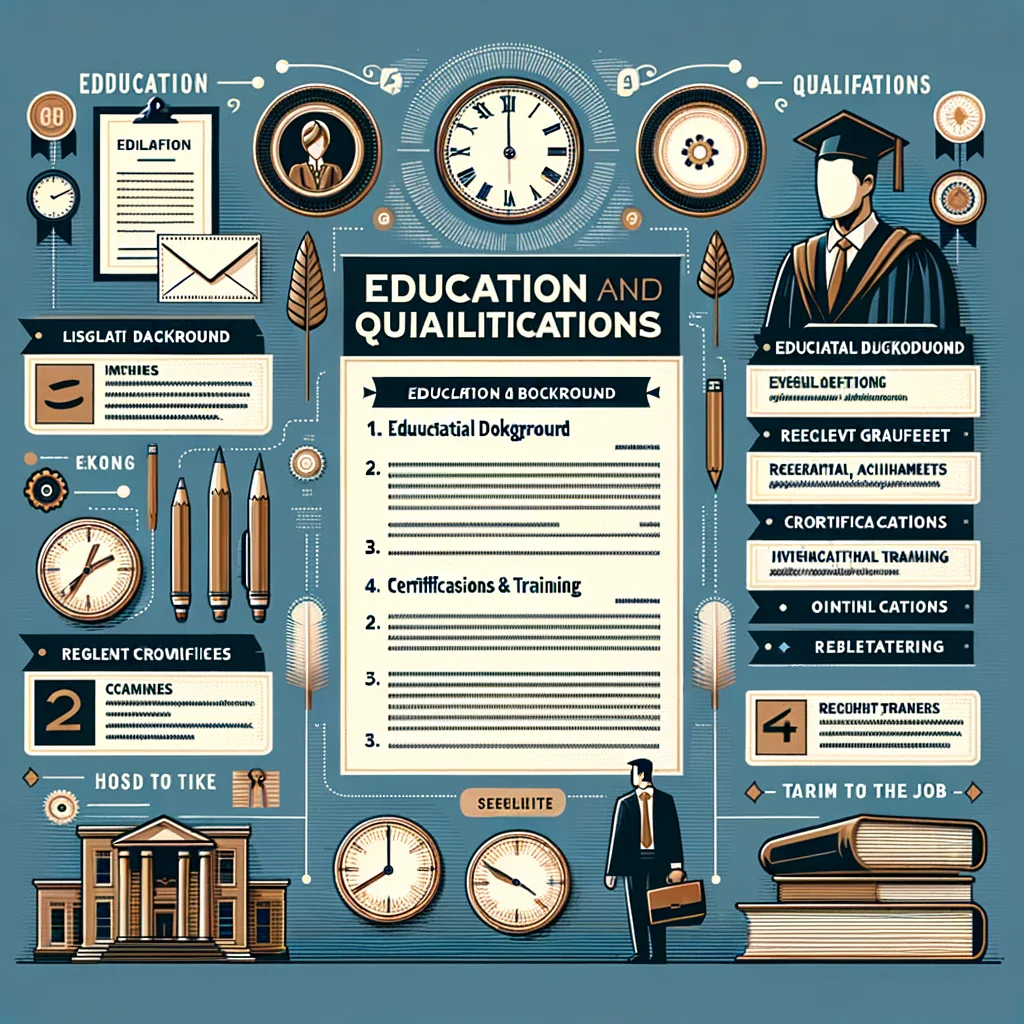
1. Listing Your Educational Background
- Start with the highest degree: List your highest degree first, followed by others in reverse chronological order.
- Include essential details: For each degree, include the name of the degree, the institution, and your graduation year.
2. Relevant Coursework and Achievements
- If you’re a recent graduate, you might want to include relevant coursework or academic achievements that demonstrate your skills and knowledge.
3. Certifications and Training
- Professional certifications: Include any certifications that are relevant to the job. These can be a great way to show you have the necessary skills and knowledge.
- Ongoing training: If you’re taking any courses or training programs currently, they can also be included to show your commitment to continuous learning.
4. Tailoring to the Job
- Just like with your professional experience, tailor this section to the job. Highlight education and qualifications most relevant to the position.
Remember, the education section is not just about degrees. It’s an opportunity to show how your educational and training experiences make you a great fit for the job.
How to Write a Resume: Skills and Abilities
In the Skills and Abilities section, you highlight the specific talents and competencies that make you a strong candidate. Here’s how to effectively showcase your skills:

1. Identifying Your Skills
- Hard Skills: These are technical or specific skills you’ve learned through education or experience, like software proficiency, foreign language fluency, or machine operation.
- Soft Skills: These are interpersonal skills like communication, teamwork, problem-solving, and adaptability.
2. Listing Relevant Skills
- Match the Job Description: Look at the job listing and identify which skills are most relevant. Prioritize these in your resume.
- Be Specific: Instead of saying “good communication skills,” specify “experienced in public speaking and client presentations.”
3. Show, Don’t Just Tell
- Where possible, provide examples of how you’ve used these skills in a professional setting. For instance, “Used Adobe Photoshop to design promotional materials that increased brand engagement by 30%.”
4. Organizing Your Skills
- Categorize Your Skills: Group similar skills together to make them easier to read.
- Keep it Concise: List only the skills that are relevant to the job to avoid cluttering your resume with unnecessary information.
Remember, your skills section is a snapshot of what you bring to the table. Make it count by being clear, relevant, and specific.
How to Write a Resume: Additional Sections to Consider
Apart from the standard sections on a resume, there are additional elements you can include to further showcase your suitability for a role. Here’s what you can consider:
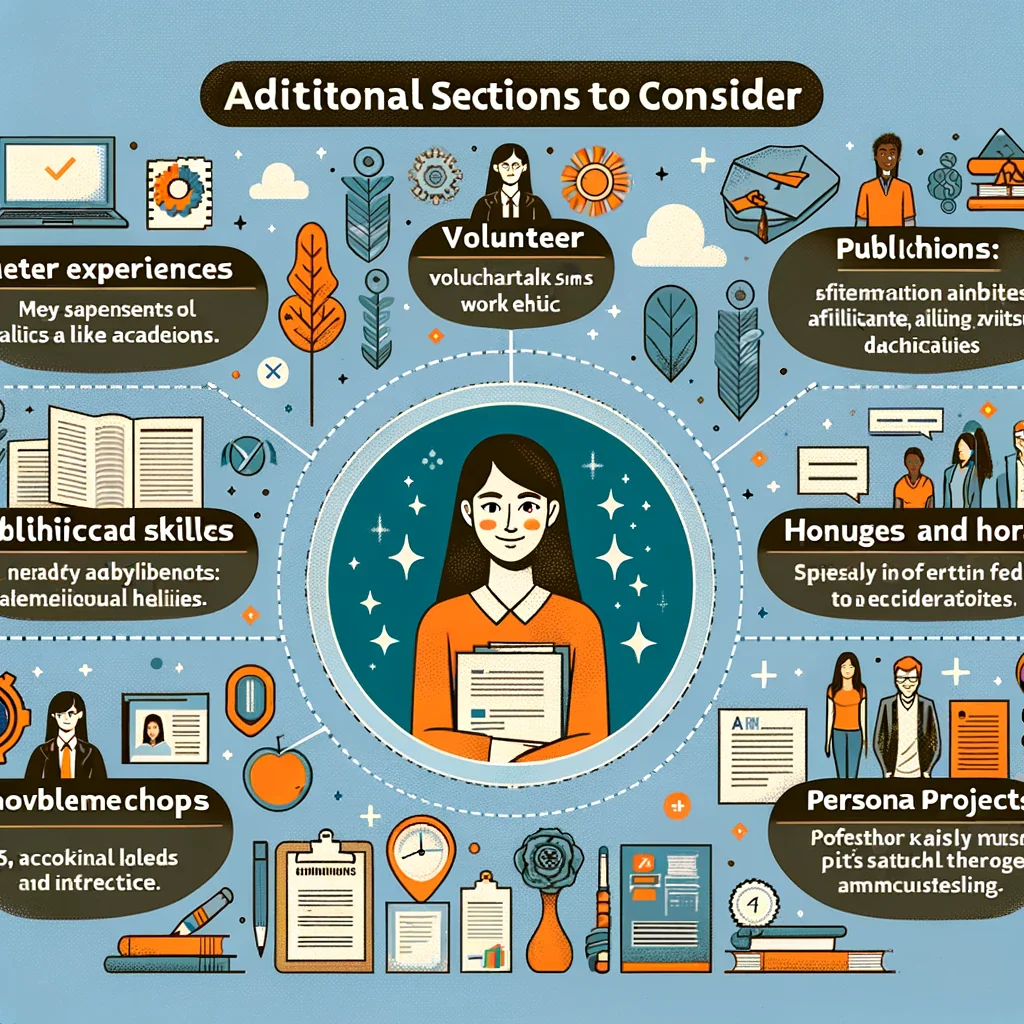
1. Volunteer Experiences
- If you have volunteer experience that showcases relevant skills or work ethic, include it. It can be particularly valuable if you’re early in your career or transitioning to a new field.
2. Publications or Projects
- For roles in academia, writing, or other fields where publications are key, list any relevant work. Similarly, highlight significant projects that showcase your skills.
3. Languages and Technical Skills
- Being bilingual or multilingual can be a significant asset in many roles. Similarly, technical skills, especially in IT and engineering, are worth mentioning.
4. Hobbies and Interests
- While not always necessary, hobbies and interests can be included, especially if they demonstrate skills relevant to the job or provide insight into your personality and work ethic.
5. Professional Memberships and Affiliations
- Membership in professional organizations can show your commitment to your field. Include any active roles or significant contributions.
6. Awards and Honors
- Recognitions and awards, whether academic or professional, can bolster your credentials and highlight your achievements.
7. Personal Projects
- Personal projects related to your field can demonstrate initiative, creativity, and passion. They can be particularly impactful in creative or technical fields.
Remember, these additional sections should complement your resume, not clutter it. Choose to include those that add value to your story and are relevant to the job you’re applying for.
How to Write a Resume: Design and Formatting Your Resume
The design and formatting of your resume are just as important as the content. A well-designed resume can make a great first impression and ensure that your information is easy to read and understand. Here’s how to do it right:

1. Choosing the Right Format
- Chronological, Functional, or Combination: Select a format that best showcases your strengths and aligns with your career history.
- Consistency is Key: Maintain consistent formatting throughout your resume, including font type, size, and color scheme.
2. Visual Appeal
- Clean and Professional: Use a clean layout with ample white space. Avoid cluttering with too much text or graphics.
- Readability: Choose a font that is easy to read, like Arial or Calibri, and keep the font size readable (typically 10-12 points).
3. Use of Color
- Subtle and Professional: If you decide to use color, do so sparingly. Stick to one or two colors for a professional look.
- Match the Industry: More creative industries may allow for more vibrant colors, while traditional fields might prefer a more conservative approach.
4. Tailoring Your Resume
- Customize for the Job: Adapt your resume’s design to suit the job and industry. A graphic designer’s resume might look different from an accountant’s.
5. Testing the Layout
- Print and Review: Sometimes, printing your resume can reveal layout issues that are not visible on a screen.
- Get Feedback: Share your resume with mentors or peers for constructive feedback.
Remember, your resume’s design should complement its content. It should be pleasing to the eye and easy to navigate, helping the reader focus on your qualifications and achievements.
How to Write a Resume: Proofreading and Finalizing Your Resume
The final step in creating your resume is just as crucial as the first. Proofreading and finalizing your resume ensures that it’s free of errors and presents you in the best possible light. Here are key points to remember:
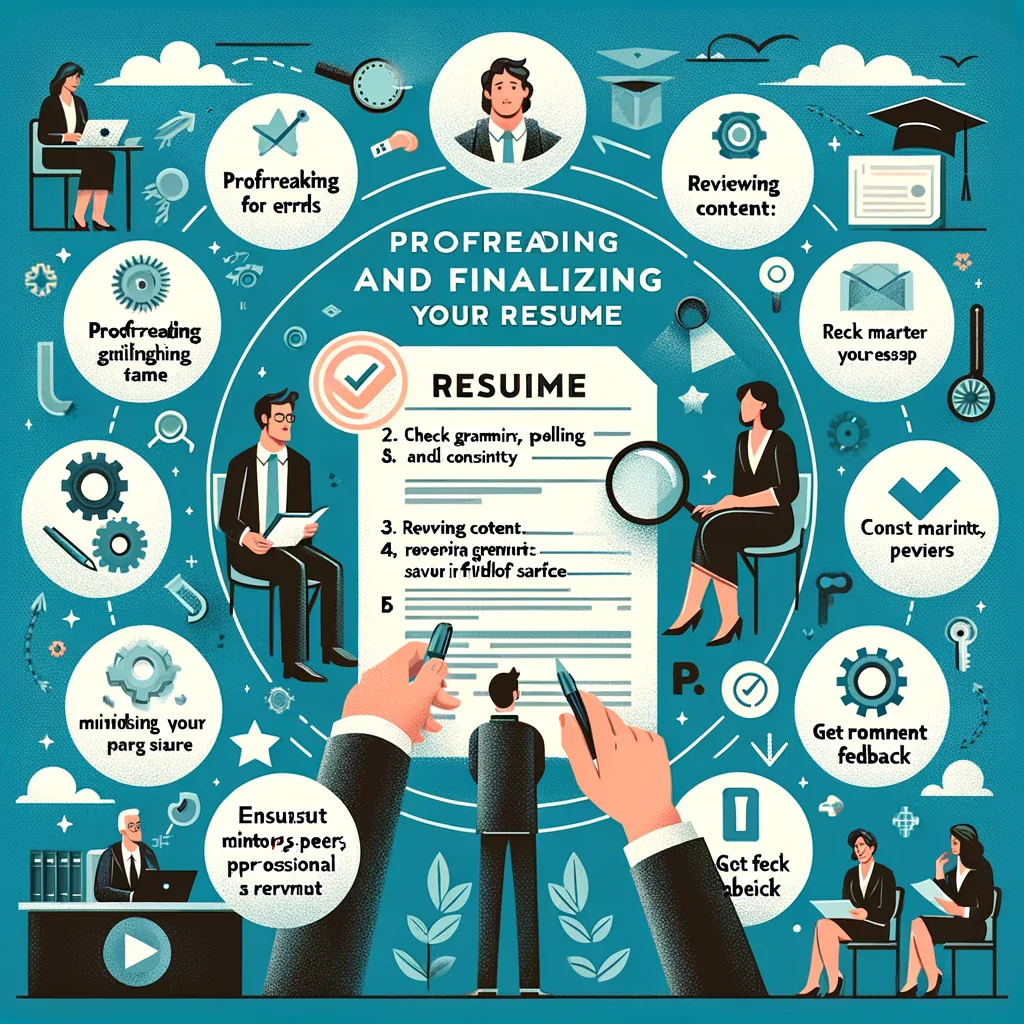
1. Proofreading for Errors
- Grammar and Spelling: Use tools like Grammarly, or ask someone to proofread your resume. Even small errors can be a red flag to employers.
- Consistency: Check for consistent use of tense, formatting, and style throughout your resume.
2. Finalizing the Format
- Alignment and Margins: Ensure everything is aligned and margins are even. Inconsistent formatting can make your resume look unprofessional.
- File Format: Save your resume in a widely accepted format, like PDF, to ensure it looks the same on every computer.
3. Reviewing Content
- Relevance and Clarity: Make sure every section of your resume adds value and your achievements and skills are clearly articulated.
- Brevity: Keep your resume concise. Aim for one page if you’re early in your career, two pages if you have more experience.
4. Getting Feedback
- Mentors or Peers: Having someone else review your resume can provide new perspectives and catch errors you might have missed.
- Professional Services: If you’re unsure, consider using a professional resume review service.
Remember, your resume is a reflection of your professionalism and attention to detail. Taking the time to proofread and finalize it can make a significant difference in your job search.
How to Write a Resume: Resume Writing Resources and Tools
Creating a standout resume can be much easier with the right resources and tools. This section provides some recommendations to help you in the resume writing process.
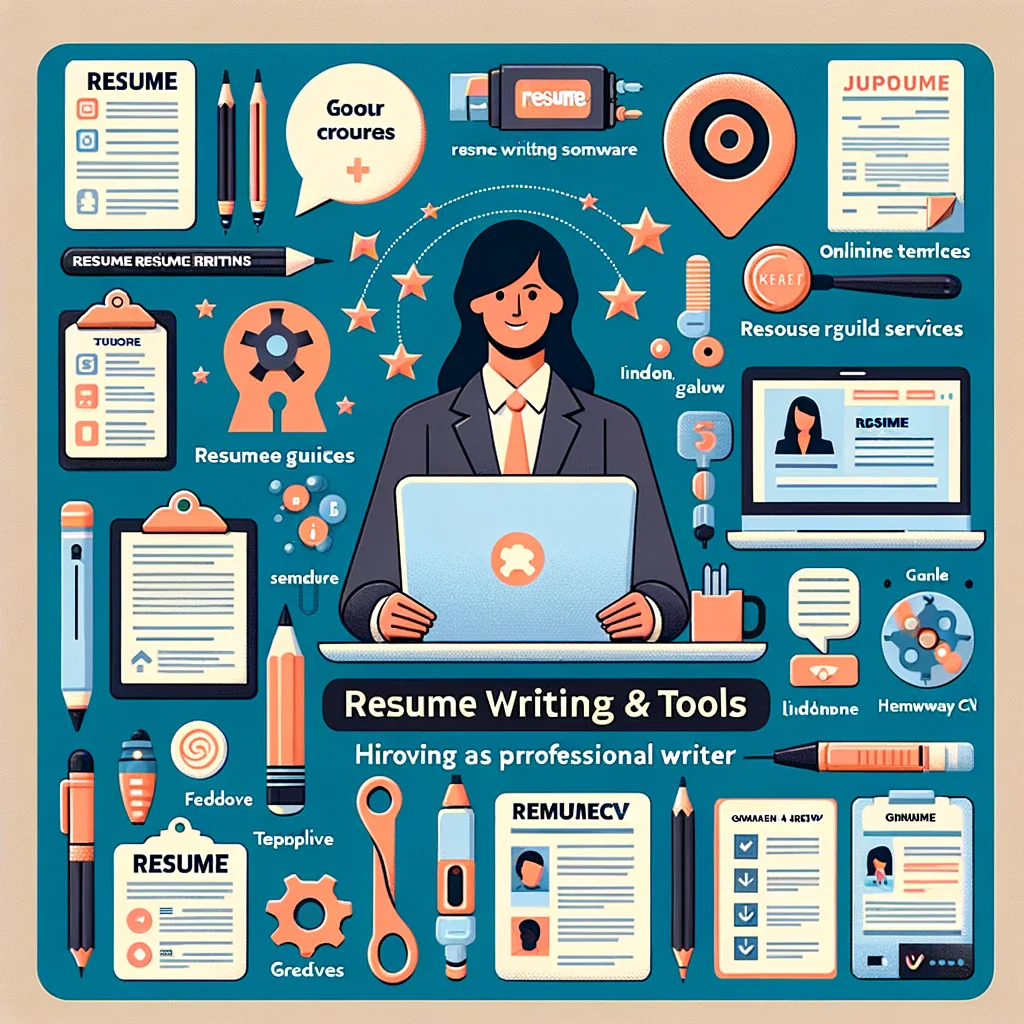
1. Resume Writing Software
- Tools like Canva, VisualCV, or ResumeGenius offer templates and design elements to create visually appealing resumes.
- These platforms often include tips and content suggestions to enhance your resume.
2. Professional Resume Writing Services
- If you’re struggling to write your resume, consider hiring a professional resume writer. They can offer personalized advice and create a high-impact resume.
3. Online Guides and Templates
- Websites like LinkedIn, Indeed, and Monster provide free resume templates and writing guides.
- These resources are great for understanding the basics and getting inspiration.
4. Feedback and Review Platforms
- Utilize platforms where you can get feedback on your resume from professionals or peers, like TopResume or Ladders.
- This feedback can be invaluable in refining your resume.
5. Grammar and Spell-Check Tools
- Use tools like Grammarly or Hemingway Editor to check for grammatical errors and improve readability.
Remember, these tools and resources are meant to assist you. Your personal touch and authenticity should still shine through in your final resume.
Conclusion
Congratulations on making it through this comprehensive guide on how to write a resume! Let’s quickly recap the key takeaways:
- Understand the Basics: Know the different types of resumes and choose the right format for your needs.
- Preparation is Crucial: Gather all necessary information and understand the job description before you start writing.
- Content is King: Write a compelling header, showcase your professional experience, education, skills, and any additional relevant sections.
- Design Matters: Pay attention to the layout, format, and overall visual appeal of your resume.
- Proofread and Finalize: Ensure your resume is error-free and polished.
- Use Resources Wisely: Utilize various tools and resources to enhance your resume.
Remember, your resume is more than a document; it’s a representation of your professional journey and a key to unlocking new career opportunities. Writing a great resume requires time, effort, and attention to detail, but with these guidelines, you’re well-equipped to create a resume that not only looks good on paper but also tells your unique story in a compelling way.
Best of luck in your job search and career journey. Go out there and make a great first impression!



